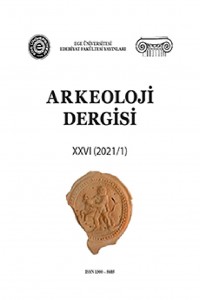Eğrekbaşı'nı Yeniden Değerlendirmek-Parion Güney Nekropolü'nden Bir Gömü Alanına Topografik ve Konteks İçerikli Bir Düzeltme
Öz
Troas’ın en önemli antik liman kentlerinden biri olan Parion özellikle nekropolü ile Anadolu arkeolojisine önemli katkılar sağlamıştır. Kentin güney nekropolünün bir bölümünü teşkil eden ve 2005 yılından itibaren neredeyse kesintisiz bir şekilde kazılan Tavşandere, kentin gömü alanları, adetleri ve mezar tipolojisi hakkında ana bilgi sağlayıcımız olmuştur.
Ancak, Tavşandere’nin yaklaşık olarak bir kilometre güneyindeki bir mevkide 2016 yılında gerçekleştirilmiş olan bir kurtarma kazısı bu durumu değiştirmiştir. Oldukça kısıtlı bir alanda gerçekleştirilen bu kazı ikisi sanduka mezar biri lahit olacak şekilde üç mezar açığa çıkarmıştır. Sanduka mezarlardan özellikle bir tanesi oldukça zengin takılar içeren repertuvarı ile dikkat çekmektedir. Bu yeni keşfedilmiş gömü alanı Parion’un güney nekropolünün büyüklüğü, topoğrafyası ve düzenlenişi hakkındaki bilgilerimizi değiştirecek bir potansiyele sahiptir. Daha önceleri iki yayın bünyesinde irdelenmiş olan bu yeni gömü alanı yine de Troas’ın ölü gömme arkeolojisi dâhilindeki yerini tam alamamıştır.
Bu çalışma, bu yeni gömü alanını tekrardan irdelemek adına, onun topoğrafyası, düzenlenişi ve buluntularına yeni ve güncel bakış açılarıyla yaklaşmayı hedeflemektedir. Bunu başarabilmek adına bu gömü alanının topoğrayası, mezar tipolojisi ve en önemlisi de buluntuları yeniden değerlendirilecek, benzerleri ile karşılaştırılacak ve bölgedeki diğer nekropoller ile irdelencektir.
Anahtar Kelimeler
Kaynakça
- AMORE 2016: M.G. Amore, "The Complex of Tumuli 9, 10 and 11 in the Necropolis of Apollonia (Albania). A Time Span from the Early Bronze Age to the Early Hellenistic Period", In: O. Henry, U. Kelp (Eds.), Tumulus as Sema - Space, Politics, Culture and Religion in the First Millenium BC, Berlin, 57-73.
“Eğrekbaşı” Revisited - A Topographic and Contextual Correctum to a Burial Ground from the Southern Necropolis of Parion
Öz
Parion, one of the most important port cities of Troad, possesses great importance to Anatolian archaeology with its necropolis. Excavated continuously since 2005, a small portion of the cities southern necropolis, named Tavşandere, became the leading information provider for the understanding of the organisation of the cities burial grounds, funerary customs and grave typology.
However, a small rescue excavation conducted nearly a kilometre south of the Tavşandere tends to change this situation. This rescue excavation that took place within a small-scale area revealed two cist graves and one sarcophagus. Especially one of the cist graves attracted attention with its very rich inventory of jewellery. This new burial ground possesses the potential to change our state-of-the-art knowledge on the size, topography and organisation of Parion’s southern necropolis. Evaluated under two publications this new burial ground from the hinterland of Parion still did not find its deserved place within the funerary archaeology of the Troad.
This paper aims to re-evaluate this new burial ground, its topography, organisation and finds with some updated knowledge, new points of view and more in-detail comparanda. To do so, the topography, grave typology and most importantly the find repertories of this burial ground will be re-examined, compared with parallels and evaluated with the other burial grounds of the region.
Anahtar Kelimeler
Kaynakça
- AMORE 2016: M.G. Amore, "The Complex of Tumuli 9, 10 and 11 in the Necropolis of Apollonia (Albania). A Time Span from the Early Bronze Age to the Early Hellenistic Period", In: O. Henry, U. Kelp (Eds.), Tumulus as Sema - Space, Politics, Culture and Religion in the First Millenium BC, Berlin, 57-73.
Ayrıntılar
| Birincil Dil | İngilizce |
|---|---|
| Konular | Arkeoloji |
| Bölüm | Araştırma Makaleleri |
| Yazarlar | |
| Yayımlanma Tarihi | 6 Mayıs 2021 |
| Yayımlandığı Sayı | Yıl 2021 Cilt: 1 Sayı: 26 |


